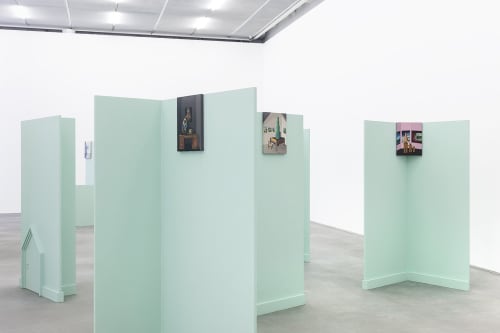Max Gómez Canle: La distancia termina en el barranco: Casa Triângulo, São Paulo, Brazil
BAROQUE AND CHASM
There is no origin, or everything is conceived together, in this miracle. All of these distances that hang here on the walls are spaces of time, color, brushes, rhythm, form... They are paintings, but they are magic mirrors. They enchant us with the possibility of telling the life of what we do, as though we had moved a piece of furniture. In the divine spirit of time, in our compressed and infinite consciousness, a sofa or writing desk shout, manifesting themselves in an ordinary way among so much detail. A piece of furniture moves because there is a force for it to slide from one side of the house to the other, but also because there is a corner that limits it. In the painting of the monkey there seems to be a corner, but it is the painting of a corner. Without a corner there either is mobility or, as in one of the paintings, there are skies that hang from skies. The only real corner is called confinement, which is the limit of anything that we can feel: behind this is the insanity or our rebirth.
There is distance because the abysses always have abysses, in turn. Every distance always ends at a chasm of feeling. The struggle against what separates memory and things is achieved with the expansion of the imagination. The exercise of finding the thread that unites the distant in a twinkling. The only inexistent distance is between body and consciousness, between name and body. We are what we are and what we know we are. All of this is our body. Saying “our body” is thus the same as saying “us.” Stated more clearly: saying “our body” is to resign oneself to the false distance between flesh and animus.
There is no model. Every model is in this imagination. Rather, there are representations that proliferate without our knowing where they come from. The allegory is to bring this together in the perception. To copy oneself to oneself (compile oneself and complicate oneself) requires a project of personal acceleration. Everything we have done returns to pass through the channels of the feelings, which are the same route with different attractions each time. The copy appears as a plow that passes through the heart and makes it uneasy. These paintings are real renders, models that represent models, like true trading cards. Argentine artist Claudia del Río aptly described it: “handmade photocopies.” This is the distinct and same relation between what we know and the expressions.
(A watery white beverage, a poster of moralist cruelty, an inclination of the rich toward the destruction of the soul... That’s how things are in our countries. Therefore, the proposal here is for real participation through the unreal in order to indicate that there are other paths of the head, of form, of waiting. We wait, but observing artworks like this. This is no longer waiting, but rather preparing for the leap.)
There are minimal points for espousing the miniature. The miniature is an example of how the insistence on counting things is one-half entertainment and the other half fatality. We can always count something more. Max had already done this in the project Amigos del siglo XX: the impudence of the copy and mimetic precision which are more a sensible grace than a flourish.
There is neither progress nor calculation. The charm of the baroque allows the capture of the movement of life in each artwork which is in itself unfinished: it is a moment. This is to say that it allows us to define the movement with a precision that is up to us. As Leónidas Lamborghini has stated, that which turns is the turning itself, it is the only cycle we are part of. Like the yirar [to wander or ramble], which is the liberating way of belonging to that which moves. We are standing before a well to which one rises by an elevator that brings us to the forgetting of the heights and a ladder that brings us to the ceiling of that elevator.
There is a sign of the other side of these words and behind the sign a book recommends escaping from the totalities to tell what was done throughout a long period. After this explanation is what Max Gómez Canle did under the adventure of art. But it does not end there, the pillar of these adventures is his own life, his non-artistic moments, his feelings, his lineage and the materiality of the streets and the houses that formed him. These same places that continue there, waiting for us to inhabit them as though they were a greenish plain from which we put forth the prayer to find our way back to what we are.
There is no rope that binds anyone to say what a sensation is, this is the most brilliant and general realization of the art of all times, including this one. Being able to imagine, in the reality of our present, what came before and what is to come as a single image of tropical and melancholic devotion.
Juan Laxagueborde


